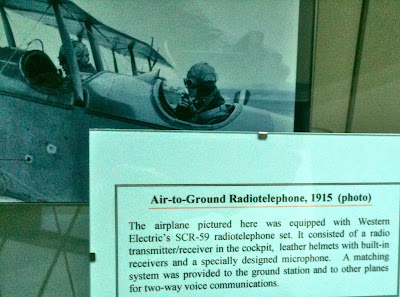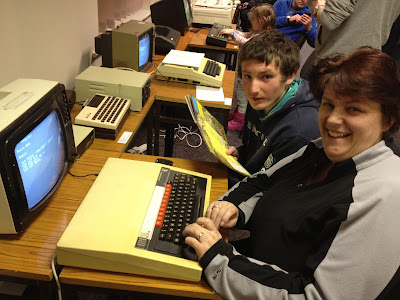 |
| Curator Toby Joyce with the Telstar replica at the Bells Lab technology museum, Alcatel-Lucent plant, Dublin |
Links have already being established with Bell Laboratories through its parent company Alcatel-Lucent which has a fantastic museum at its plant in Blanchardstown Dublin. Bell Labs, named after its founder the telephone inventor Alexander Graham Bell, is probably the greatest scientific research establishment of all time, responsible for inventions such as the air-to-ground Radio-Relephony, TelePhotograph (fax) receiver, Vitaphone projector (synchronisation of sound with movie), the Transistor and the Telstar.
 |
| Air-to-Ground Radiotelephone 1915 display, Alcatel-Lucent, Dublin |
 |
| Manual operated Switchboard, Telephone Exchange, Newbliss Monaghan |
Toby is originally from Clifden and worked in DEC Galway during the 1970s and 1980s.
 |
| Computer and Communications Museum of Ireland, Galway |
This Galway-based Computer and Communications Museum of Ireland museum provides a
fascinating insight into advances in communications and computing from ancient
hieroglyphics to today’s Internet.
 |
| Enjoying Vintage Computer Gaming at the Computer and Communications Museum |
The array of
electronic artifacts on display include such iconic computers as the DEC PDP11, Apple II, IBM PC, ZX81 and Commodore Vic-20. Special themes
include Computing in Ireland, early
Radio, Steve Jobs & Apple Computers, Youth & Innovation, Women in
Technology, and a vintage video games section with classics such as ‘Sonic the Hedgehog’, ‘Pacman’ and ‘Space
Invaders’. It also endeavours
to ensure that the facility is innovative and inspirational to a younger
audience by organising regular vintage gaming, computer
programming and ‘maker’
workshops.”
 |
| An Taoiseach Enda Kenny listens to Frank McCurry explain the workings of vintage Radio at the Computer and Communications museum |
Click here to access the computer museum website.
 |
| Revisiting the micros of the early 1980s |
Hurdy Gurdy (Radio) Museum
There are other wonderful technology heritage facilities across Ireland including at Birr Castle, the location of the world's largest telescope and at the Hurdy Gurdy Radio museum at the Martello Tower in Howth which has a remarkable eclectic collection of 20th century radios and gramophone players.
The Howth building itself has strong associations with the development of telecommunications in Ireland.
For instance, the first telegraph line under the Irish Sea was terminated in the tower in 1852 and Guglielmo Marconi, the inventor of the wireless radio, undertake radio transmission experiments from it in 1913.
Click here to access the Hurdy Gurdy museum website.
Engineering and Astronomy Museum, Birr Castle
The museum at Birr Castle county Offaly is dedicated to the scientific discoveries and innovations of the Earls and Countesses of Rosse of the 19th century who were responsible for their place of residency being an internationally acclaimed hub for science and technology. The science facility housed in the renovated stables explores the wonders of Victorian photography, engineering and astronomy with a special emphasis on the brilliant design of the world famous Great Telescope.
Built in the 1840s, it was for over 70 years the largest telescope in the world. Its builder the third Earl of Rosse used it to discover the spiral nature of some of the galaxies. Today, its promoters claim it is probably the largest historic scientific instrument in operation today.
Click here for access to the Birr Castle website




No comments:
Post a Comment